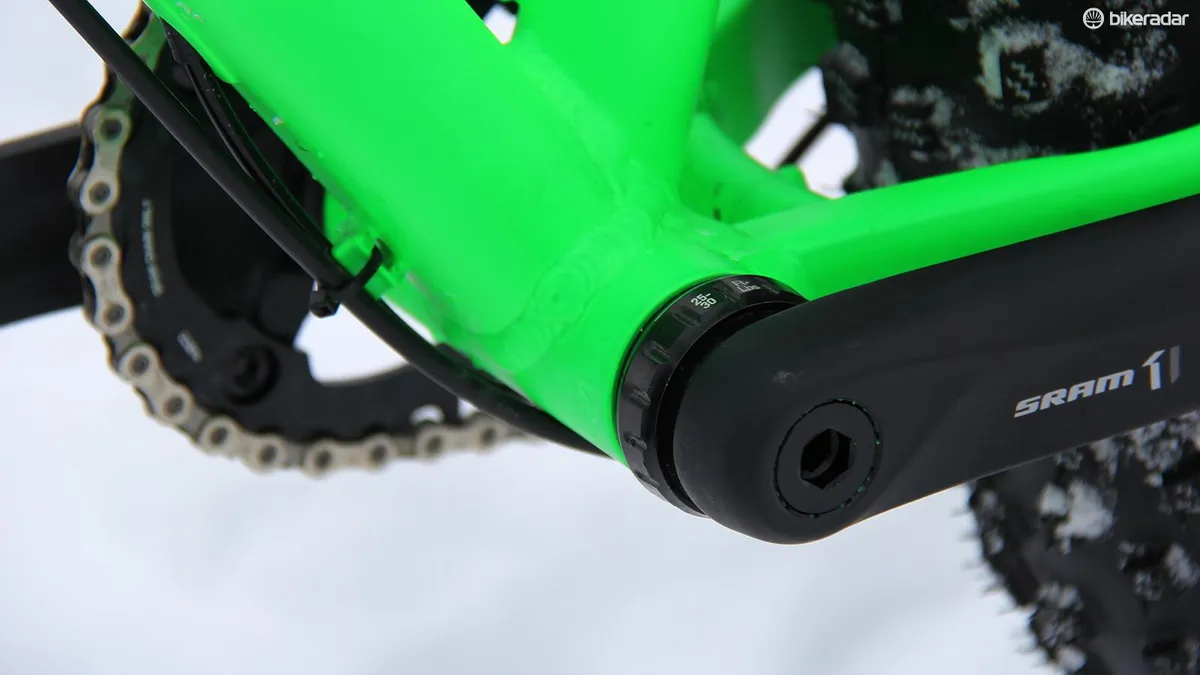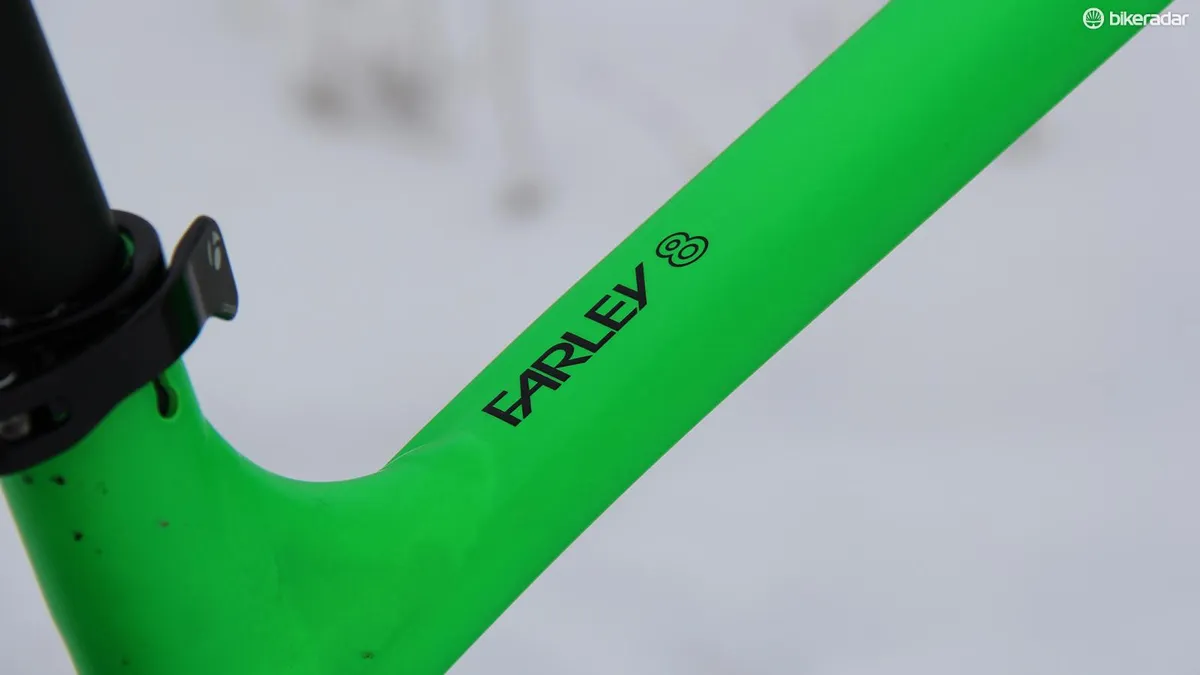Trek designed the Farley around 4in tires with geometry that places an emphasis on fun and agility. According to Trek mountain bike brand manager Travis Ott, Trek built the Farley around the smaller but still voluminous 26x4in tire standard out of desire to create a fast and light fat bike that handles like a regular mountain bike. To that end we’d say Trek succeeded, because while there are better fat bikes for winter riding, few others come close to being as fun to ride year-round as the Farley.
- Highs: Surprising agility, dropper-seatpost compatible
- Lows: Limited tire clearance, slow freehub engagement
- Buy if: You’re in the market for a capable four-season fatty
Ride and handling: surprisingly agile
The Farley was named in honor of the late comedian Chris Farley, but unlike its namesake, the Farley is far from a lumbering heavyweight.
Tight 440mm/17.3in chainstays and a snappy 70 degree head tube angle give the Farley a nimble feel. It has ample standover and, with the addition of a dropper seatpost, it handles more like a trail hardtail than a traditional fat bike, which is to say, it’s a lot of fun to ride.

The Farley features internal cable routing and has a port for a dropper seatpost
This fun factor does come with certain downsides that may or may not bother you, depending on your fat biking needs.
When riding unpacked snow, we found the stock 26x3.8in Hodag tires to lack the floatation and grip to power through the fluffy stuff. However, they made short work of groomed trails when the track was already laid down for us by riders on fatter, 5in tires.

The 26x3.8in tubelss-ready Hodag tires feature plenty of sipping on the knobs, but lack the bite to dig through deep snow
The Hodags also performed admirably on dirt. They rolled quickly and predictably over hardpack and loose and rocky trails. The only dry terrain where they didn’t pass muster was deep sand. Much like unpacked snow, deep sand requires tires with a taller knobs and a paddle-like tread to push the rider forward.
Last but certainly not least, the importance of running fat bikes tires set up tubeless cannot be overstated. It’s not just about saving weight (although it certainly helps), it also prevents a lot of flats. When it comes to fat bikes, there’s a lot of rubber in contact with the trail, and you’re bound to pick up more thorns than with skinny tires. The Bontrager Jackalop TLR wheelset is light and allowed us to inflate the Hodags with a floor pump, we only wish the hubs had better engagement.
Build and equipment: sorted frame and solid spec
Trek introduced the Farley in 2013 for the 2014 model year and they sold like hotcakes. For 2015, Trek offers the Farley in two build levels. The Farley 8 we tested here and the more affordable Farley 6, which comes with a 2x10 drivetrain and a rigid fork.
Both models share the same aluminum frame with a 170mm rear thru-axle, 100mm-wide threaded bottom shell and a low-direct mount front derailleur mount. The Farley even has a port for an internally-routed dropper seatpost.
The Farley 8 comes equipped with SRAM’s very capable X1 drivetrain with a 30t front chainring. We found this to be a good gearing for the majority of our trail riding.

We continue to be impressed by SRAM's budget-minded 1x11 group
Braking is provided by a pair of Avid DB 3 brakes. This was the only lackluster component on this otherwise solid build. Their dull lever feel and lack of modulation left much to be desired. On the plus side, they performed acceptably regardless of how low the mercury dropped.
The RockShox Bluto takes the edge off impacts and keeps the front tire tracking true. Yes, a stiffer fork with more refined damping would be nice, but we give thanks to RockShox for stepping up to meet pent-up demand for a quality fat bike suspension fork at a reasonable price point. Maybe we’ll see a Pike for fat bikes in the coming years. In the meantime, the Bluto gets the job done without much fuss.

The RockShox Bluto is essentially a wider version of the Reba
Trek’s parts, accessories and clothing brand, Bontrager, supplies the alloy cockpit components as well as the most critical fat bike components: wheels and tires.
The Farley 8 comes with Bontrager’s new Jackalope rims. These 80mm-wide rims incorporate Bontrager’s TLR tubeless-ready system and when paired with the stock 26x3.8in Hodag TLR tires can remove a sizeable chunk of rotational weight from the bike.
In total, our size 17.5 tester weighed a very respectable 28.8lb/13.1kg (without pedals, set-up tubeless). That’s not bad for an affordable aluminum fat bike with a suspension fork.
Verdict
The Farley is the svelte sumo wrestler of the fat bike world. It lacks the ability to power through deep powder, but outshines its fatter competitors on packed snow, groomed trails and summer singletrack. If you’re willing to let the bigger boys break trail, or are looking for a four-season fat bike, the Farley 8 is an excellent choice.

Complete bike specifications
- Frame: Trek Farley (aluminum)
- Fork: RockShox Bluto RCT3, 100mm travel
- Headset: FSA integrated, 1 1/8-to-1 1/2in tapered
- Stem: Bontrager Race Lite, 70mm
- Handlebar: Bontrager Race Lite Riser, 15mm rise
- Front brake: Avid DB 3, 160mm rotor
- Rear brake: Avid DB 3, 160mm rotor
- Rear derailleur: SRAM X1
- Shift lever: SRAM X1
- Cassette: SRAM XG-1180
- Chain: SRAM PC-1130
- Crankset: SRAM X1 1000, 30t chainring
- Wheels: Bontrager Jackalop
- Front tire: Bontrager Hodag, 26x3.8in
- Rear tire: Bontrager Hodag, 26x3.8in
- Saddle: Bontrager Evoke 2
- Grips: Bontrager Race Lite Lock-On
- Seatpost: Bontrager Rhythm Elite, 31.6mm












